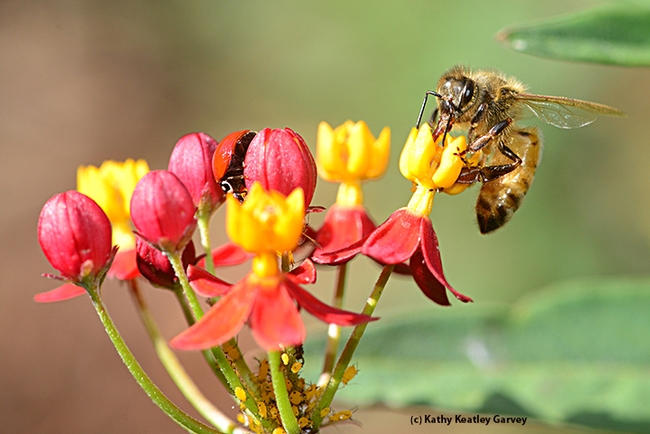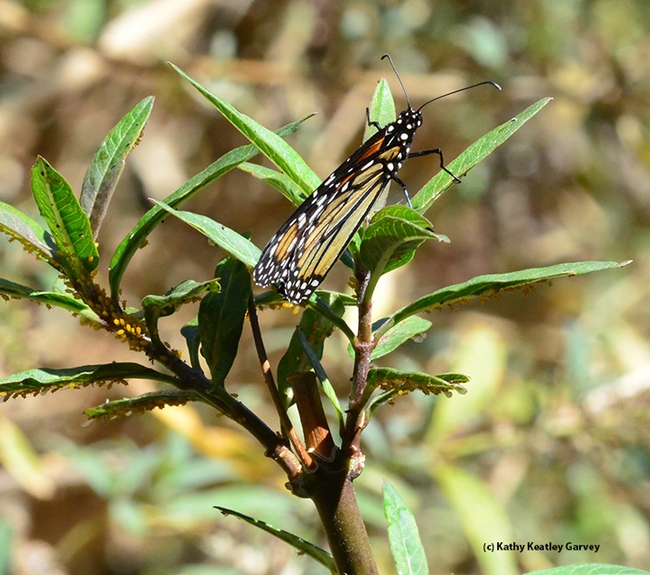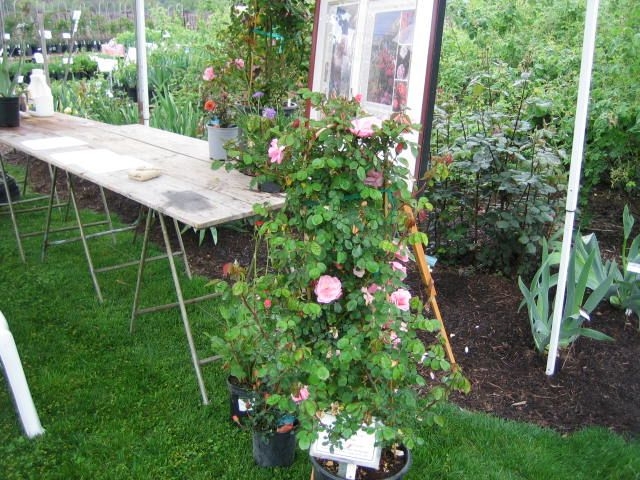Posts Tagged: lady bugs
Guess What Other Insects Like Milkweed!
Monarch butterflies aren't the only insects that like milkweed. Honey bees, lady beetles and aphids, do, too. We found all three insects, plus a...

Labor Day activity: A honey bee and a lady beetle (see center of blossoms) forage on a scarlet milkweed. (Photo by Kathy Keatley Garvey)

Oleander aphids also like the scarlet milkweed (along with honey bees and monarch butterflies). The milkweed is the host plant of the monarch butterfly but this plant "hosts" other insects, too. (Photo by Kathy Keatley Garvey)

A monarch butterfly laying eggs on a scarlet milkweed. (Photo by Kathy Keatley Garvey)
How Small Is Small?
Sometimes in a world of towering skyscrapers, jumbo jets and warehouses big enough to hold a small planet--or at least a state the size of...

A lady beetle, a monarch caterpillar and an infestation of oleander aphids. (Photo by Kathy Keatley Garvey)

An oleander aphid on "the nose" of a monarch caterpillar. (Photo by Kathy Keatley Garvey)

An oleander aphid on the back of a monarch caterpillar. (Photo by Kathy Keatley Garvey)

An oleander aphid crawling on a tentacle of a monarch caterpillar. (Photo by Kathy Keatley Garvey)
The Good Guys--and Girls!
Think of them as "the good guys" and "the good girls." Insects such as lacewings, lady beetles and flower flies. We're delighted to see that the...

A syrphid fly, aka flower fly or hover fly, nectaring on a tower of jewels. (Photo by Kathy Keatley Garvey)

A lacewing glows in the afternoon sun. Larvae eat such soft-bodied insects as mealybugs, psyllids, thrips, mites, whiteflies, aphids, small caterpillars, leafhoppers, and insect eggs, according to the UC IPM website. (Photo by Kathy Keatley Garvey)

The lady beetle, aka ladybug, is well known for its voracious appetite of aphids. (Photo by Kathy Keatley Garvey)
Lady bugs need special care to control aphids in the garden
Many retail nurseries and garden centers sell lady beetles for controlling aphids in gardens and landscapes. Gardeners often ask, “Does releasing lady beetles really work?”
Lady beetles sold at nurseries for aphid control are convergent lady beetles, named for the converging white marks on its thorax. Suppliers collect beetles from large overwintering aggregations in California's foothills and mountains. Many other species of lady beetles occur naturally in California landscapes but don't aggregate in the mountains and aren't sold commercially.
University of California research has demonstrated that lady beetle releases can effectively control aphids in a limited landscape or garden area if properly handled and applied in sufficient numbers. However, because of inadequate release rates or poor quality, lady beetles often fail to provide satisfactory control. Other low toxicity aphid management practices, such as hosing off or insecticidal soap or oil sprays, may be more effective. Here are some things to consider if you decide to try lady beetle releases:
Lady beetles deteriorate rapidly if not handled properly. Lady beetles need to be kept refrigerated until they are released. Live lady beetles on display in stores are attractive for customers, but beetles left out at room temperature rapidly deteriorate. Also, lady beetles are often dehydrated and need water, especially if they have been held at room temperature, even for a few hours. Stores or gardeners are advised to mist lady beetles with water in a squirt bottle before placing them in the refrigerator for storage, making sure not to let water puddle in containers. When purchasing lady beetles, inspect the container and make sure almost all beetles are alive. Lady beetles purchased from primary suppliers (those who obtain beetles directly from collectors) may be healthier than those held in stores for several weeks.
Use adequate release rates. UC research shows that high numbers of lady beetles are required to control aphids. One large, heavily infested rose bush in the landscape required two applications of about 1,500 lady beetles each, spaced a week apart. Most packages sold in stores contain only enough lady beetles to treat one aphid-infested shrub or a few small plants. Larger qualities can be purchased from online lady beetle suppliers.
Lady beetles need a good supply of aphids. There is no point in releasing them on plants with few aphids. Lady beetles are voracious aphid feeders and an adult beetle will eat 50 or more aphids a day. The convergent lady beetle, which is the species sold for release, feeds almost entirely on aphids and will not remain on plants with low aphid populations and will not control other garden pests.
Release lady beetles at dusk or early evening. Lady beetles will fly away almost immediately if released during the heat of the day or where the sun is shining, so wait until evening to release them. Spray a fine mist of water on the plants before the release. Giving beetles a drink may keep them around longer. Place beetles at the base of plants or in the crotches of low branches. Lady beetles will crawl higher into the plant in search of aphids. Once lady beetles begin to fly, they are likely to fly a substantial distance, often outside the boundaries of your garden. Don't release lady beetles on plants that have been sprayed with insecticides. Residues from most insecticides are likely to kill the beetles. However, insecticidal soaps and oils, once dry, won't leave toxic residues.
Expect lady beetles to fly away in a few days. Even when released with care, lady beetles will fly away within a few days. About 95 percent of released beetles in research studies flew away within 48 hours. The remainder were gone within 4 or 5 days. Lady beetles are unlikely to lay eggs on the plants they are released on. If aphids return a week or two later, gardeners will need to release more lady beetles, hose aphids off with water, use insecticidal soap sprays, or wait for other native aphid natural enemies to fly in.
See the convergent lady beetle page in UC IPM's Natural Enemies Gallery for information about its life cycle and view journal articles about UC research on lady beetle releases for controlling aphids.
This article was modified from the original version published in the June 2011 issue of the Retail Nursery and Garden Center IPM News.
Tips on Having a Happy Rose Garden
Earlier this month, my partner and I jumped into the car and took off to Healdsburg to the Russian River Rose Company, where we arrived just in time for their 10AM talk on “Having a Happy Rose Garden”. This is a rose and iris nursery in the middle of wine country, in Sonoma County’s Dry Creek area, with a view of lush green hills in the background from the recent rains. We had been there a few times before, but each time I always pick up some new piece of information or nuance on rose growing.
Included in the talk was a demonstration of how to plant a rose, most of which I already know the basics. Basically, the hole is dug, about twice the size of the container, and back filled with a half and half mixture of potting soil/compost and soil. On the surface, they use a 6 inch cover of mulch from Sonoma Compost in Petaluma (www.sonomacompost.com), which is free of weed seeds and pathogens due to the high temperatures generated in the composting process, which is something to see in itself.
One of the handouts included “A Year in the Rose Garden”, a month-by-month guideline for gardeners. What was interesting to me is that they plant winter annuals in January interspersed with the roses for early spring color. They choose Calendulas (Calendula officinalis), Johnny Jump Ups (Viola tricolor), and Leucanthemums (L. paludosum) because they are all snail and bug resistant.
They recommend dormant spray (copper sulfate) three times to ward off fungal spores: Once right after pruning, and a second and third when new growth is about one inch and three inches out, respectively.
Fertilizer applications are recommended for March and again in August, to “reawaken” the garden for fall bloom. Included is 2 cups of alfalfa pellets as well as the usual organics dug in around each rose.
They do not use pesticides, but use ladybugs for aphid control. After receiving a shipment, ladybugs are placed in the refrigerator, to slow them down. A few ladybugs from the bag are put out at the base of the rose bush in the evening, which will keep them from flying away. They will then crawl up the branches and stay until all the aphids are gone. Dwarf Scabiosa (S. atropurpurea) is said to be a good haven for ladybugs. They will breed in it.
For irrigation, they use two half gallon per hour emitters 18 inches apart, with the rose shrub in the center, to avoid root rot.
Their instruction for July: “Minimal attention….Leave town”. And for December: “Rest and dream about what roses you would like to add to your garden next year!”
Russian River Rose Company is open to the public every weekend during April and May, so there is still plenty of time to visit their beautiful gardens. For more information, check out their website at www.russian-river-rose.com.

working in garden with kid

roses in pots

rose bud

path view of garden villa


